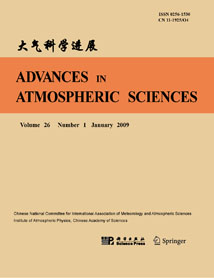| [1] |
Shui YU, Jianqi SUN,
2024: Persistent Variations in the East Asian Trough from March to April and the Possible Mechanism, ADVANCES IN ATMOSPHERIC SCIENCES, 41, 737-753.
doi: 10.1007/s00376-023-3024-7
|
| [2] |
ZHOU Xiaomin, LI Shuanglin, LUO Feifei, GAO Yongqi, Tore FUREVIK,
2015: Air-Sea Coupling Enhances the East Asian Winter Climate Response to the Atlantic Multidecadal Oscillation, ADVANCES IN ATMOSPHERIC SCIENCES, 32, 1647-1659.
doi: 10.1007/s00376-015-5030-x
|
| [3] |
WEI Ke, BAO Qing,
2012: Projections of the East Asian Winter Monsoon under the IPCC AR5 Scenarios Using a Coupled Model: IAP-FGOALS, ADVANCES IN ATMOSPHERIC SCIENCES, 29, 1200-1214.
doi: 10.1007/s00376-012-1226-5
|
| [4] |
CHEN Shangfeng, CHEN Wen, WEI Ke,
2013: Recent Trends in Winter Temperature Extremes in Eastern China and their Relationship with the Arctic Oscillation and ENSO, ADVANCES IN ATMOSPHERIC SCIENCES, 30, 1712-1724.
doi: 10.1007/s00376-013-2296-8
|
| [5] |
Xu Qun, Yang Qiuming,
1993: Response of the Intensity of Subtropical High in the Northern Hemisphere to Solar Activity, ADVANCES IN ATMOSPHERIC SCIENCES, 10, 325-334.
doi: 10.1007/BF02658138
|
| [6] |
Laura DE LA TORRE, Luis GIMENO, Juan Antonio A\~NEL, Raquel NIETO,
2007: The Role of the Solar Cycle in the Relationship Between the North Atlantic Oscillation and Northern Hemisphere Surface Temperatures, ADVANCES IN ATMOSPHERIC SCIENCES, 24, 191-198.
doi: 10.1007/s00376-007-0191-x
|
| [7] |
LIU Shan, WANG Huijun,
2013: Transition of Zonal Asymmetry of the Arctic Oscillation and the Antarctic Oscillation at the End of 1970s, ADVANCES IN ATMOSPHERIC SCIENCES, 30, 41-47.
doi: 10.1007/s00376-012-2027-6
|
| [8] |
Kairan YING, Jing PENG, Li DAN, Xiaogu ZHENG,
2022: Ocean–atmosphere Teleconnections Play a Key Role in the Interannual Variability of Seasonal Gross Primary Production in China, ADVANCES IN ATMOSPHERIC SCIENCES, 39, 1329-1342.
doi: 10.1007/s00376-021-1226-4
|
| [9] |
Bueh Cholaw, Ji Liren,
1999: The Ocean-Atmosphere Coupled Regimes and East Asian Winter Monsoon (EAWM) Activity, ADVANCES IN ATMOSPHERIC SCIENCES, 16, 91-106.
doi: 10.1007/s00376-999-0006-3
|
| [10] |
Jiapeng MIAO, Tao WANG, Huijun WANG, Yongqi GAO,
2018: Influence of Low-frequency Solar Forcing on the East Asian Winter Monsoon Based on HadCM3 and Observations, ADVANCES IN ATMOSPHERIC SCIENCES, 35, 1205-1215.
doi: 10.1007/s00376-018-7229-0
|
| [11] |
WEI Jiangfeng, WANG Huijun,
2004: A Possible Role of Solar Radiation and Ocean in the Mid-Holocene East Asian Monsoon Climate, ADVANCES IN ATMOSPHERIC SCIENCES, 21, 1-12.
doi: 10.1007/BF02915675
|
| [12] |
Hengyi WENG,
2003: Impact of the 11-yr Solar Activity on the QBO in the Climate System, ADVANCES IN ATMOSPHERIC SCIENCES, 20, 303-309.
doi: 10.1007/s00376-003-0017-4
|
| [13] |
YANG Hui,
2011: The Significant Relationship between the Arctic Oscillation (AO) in December and the January Climate over South China, ADVANCES IN ATMOSPHERIC SCIENCES, 28, 398-407.
doi: 10.1007/s00376-010-0019-y
|
| [14] |
FENG Juan*, CHEN Wen,
2014: Interference of the East Asian Winter Monsoon in the Impact of ENSO on the East Asian Summer Monsoon in Decaying Phases, ADVANCES IN ATMOSPHERIC SCIENCES, 31, 344-354.
doi: 10.1007/s00376-013-3118-8
|
| [15] |
LI Fei, WANG Huijun,
2012: Predictability of the East Asian Winter Monsoon Interannual Variability as Indicated by the DEMETER CGCMS, ADVANCES IN ATMOSPHERIC SCIENCES, 29, 441-454.
doi: 10.1007/s00376-011-1115-3
|
| [16] |
Chen Wen, Hans-F. Graf, Huang Ronghui,
2000: The Interannual Variability of East Asian Winter Monsoon and Its Relation to the Summer Monsoon, ADVANCES IN ATMOSPHERIC SCIENCES, 17, 48-60.
doi: 10.1007/s00376-000-0042-5
|
| [17] |
Se-Hwan YANG, LU Riyu,
2014: Predictability of the East Asian Winter Monsoon Indices by the Coupled Models of ENSEMBLES, ADVANCES IN ATMOSPHERIC SCIENCES, 31, 1279-1292.
doi: 10.1007/s00376-014-4020-8
|
| [18] |
Xinping XU, Fei LI, Shengping HE, Huijun WANG,
2018: Subseasonal Reversal of East Asian Surface Temperature Variability in Winter 2014/15, ADVANCES IN ATMOSPHERIC SCIENCES, 35, 737-752.
doi: 10.1007/s00376-017-7059-5
|
| [19] |
ZENG Gang, Wei-Chyung WANG, SUN Zhaobo, LI Zhongxian,
2011: Atmospheric Circulation Cells Associated with Anomalous East Asian Winter Monsoon, ADVANCES IN ATMOSPHERIC SCIENCES, 28, 913-926.
doi: 10.1007/s00376-010-0100-6
|
| [20] |
YAN Hongming, YANG Hui, YUAN Yuan, LI Chongyin,
2011: Relationship Between East Asian Winter Monsoon and Summer Monsoon, ADVANCES IN ATMOSPHERIC SCIENCES, 28, 1345-1356.
doi: 10.1007/s00376-011-0014-y
|















 AAS Website
AAS Website 
 AAS WeChat
AAS WeChat 
 DownLoad:
DownLoad: